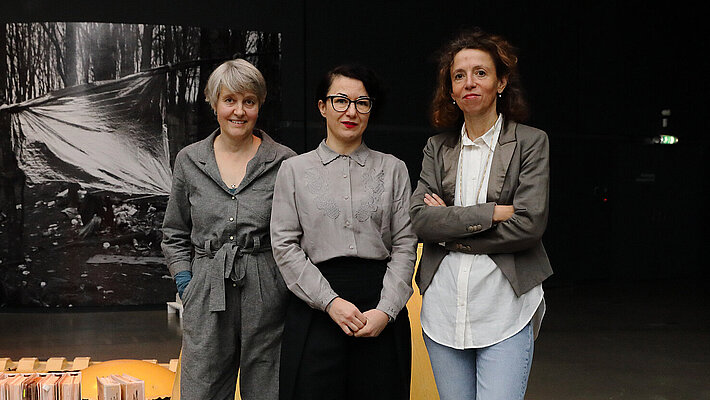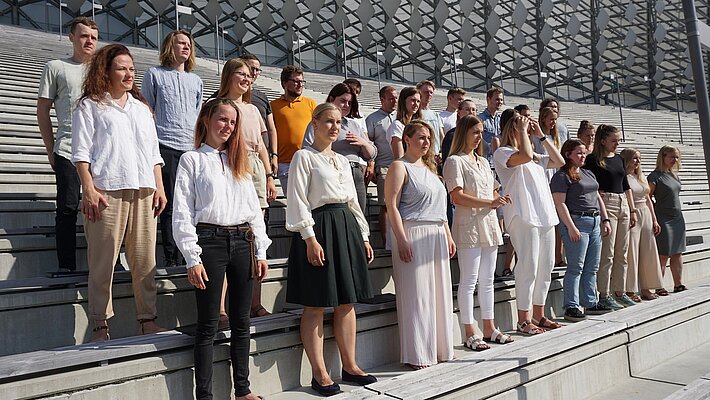|
|
|
|
|
|
Graz, 11.12.2024
Led by director Andreja Hribernik, the Kunsthaus Graz team can look back on a successful year: some 75,000 visits were recorded in the last 12 months. Today, a first preview of the 2025 programme was given: The new mission statement and an adapted design were presented, as were the extensive exhibition program and planned projects that deal with ways in which power is handled.
|
|

Curator Katia Huemer, Kunsthaus director Andreja Hribernik, chief curator Katrin Bucher Trantow, from left. Photo: Kunsthaus Graz/J.J. Kucek
|
|
|
|
|
|
|
|
|
|
|
|
The annual programme of the Kunsthaus Graz sees itself as a living organism that promotes sustainability and continuity – ranging from themes, content and working methods to long-term development. The programme continues to evolve over the years as an exhibition and production venue, laboratory, educational institution, growing archive and site-specific collection.
“In 2024, we adopted a new mission statement that anchors the Kunsthaus internationally while maintaining an intensive exchange with the local and regional art scene. This is also the basis for our three guidelines Sustainable Thinking, Opening and Sharing, which shape our annual program for 2025. The main theme for 2025, Dealing with Power, encompasses the areas of tension between oppression, empowerment and radical hope,” says the director of the Kunsthaus Graz Andreja Hribenrik.
Designing sustainably, opening up, sharing
Based on three categories from the new mission statement – ‘Designing sustainably, opening up and sharing’ – the 2025 annual programme focuses on how power is handled – from oppression and empowerment to radical hope. As an introduction to this theme, the current exhibition Poetics of Power addresses the ambivalence of power.
Long-term research topics and the development of a programme-based narrative have already been integrated as a strategy in 2024, with a focus on ‘work’. This strategy is combined with the idea of sustainability to enable a precise programmatic profile for the museum to be developed.
Questions around asymmetries of power, resistance, solidarity
The structural, political and ethical conditions we live in will be explored in 2025. The focus will be on questioning power structures and supporting systems. The main exhibitions will deal with questions of asymmetries of power, resistance and solidarity. They also address both the responsibility that goes with power and the responsibility of each individual that goes with how we view the impact of our way of life, for example. Alongside this, an all-year educational program is being developed that engages with concepts of oppression – and emancipation, too.
|
|

Anna Jermolaewa is one of many artists who will be represented in the exhibition “Freeing the Voices”, above “Singing Revolution” - video still, Anna Jermolaewa © Bildrecht Vienna, 2024/25
|
|
|
|
|
|
|
|
|
|
|
|
Exhibition overview
The first show in 2025 is the group exhibition Freeing the Voices, crafted by guest curator Zdenka Badovinac. It examines the voice as a central tool for emancipation and resistance in a world marked by wars, silence, censorship and information noise. The exhibition shows how the liberation of individual and collective voices can break silence and censorship. In this regard, it questions the very idea of an authentic voice. Works shown include those by Marina Abramović, Lawrence Abu Hamdan, Noor Abed, Babi Badalov, Selma Banić, VALIE EXPORT, Farhad Farzaliyev, Essa Grayeb, Ida Hiršenfelder, Saodat Ismailova, Anna Jermolaewa, and more besides.
In 2025, the winner of the ‘Innovative Cinema’ Prize, Simona Obholzer, will once again prepare the trailer for Diagonale '25 and an exhibition at Kunsthaus Graz. Obholzer is planning an immersive spatial installation in which she explores the theme of the ground as a fundamental subsurface. This ties in with her Diagonale award-winning film.
A solo exhibition by Milica Tomić follows at the beginning of summer, tackling issues of absence, memory, political violence and social asymmetries. With insights into the Belgrade-born artist’s practice, the survey exhibition On Love Afterwards attempts to open up and address through art such subjects as responsibility, visibility and injustice.
|
|

A solo exhibition by artist Milica Tomić is also part of the 2025 exhibition program, above: “One day, instead of one night, a burst of machine-gun fire will flash, if light cannot come otherwise” (2010), Copenhagen, photo: David Nikoliić
|
|
|
|
|
|
|
|
|
|
|
|
|
In the autumn, the Kunsthaus Graz mounts a group exhibition titled Unseen Futures to Come. Based on a concept of the philosopher Federico Campagna, the exhibition tackles the question of how we as humans deal with growing uncertainty and fear, a trend also reflected politically in a shift towards conservatism.
A special project by Rossella Biscotti forms the final exhibition. Circulations, a monumental installation, shows steel tubes that spread out in space like the tentacles of a multi-limbed organism, combining elements of archaeology, industry and science fiction. The work is based on research undertaken by the artist in the historical archive of Tenaris Dalmine in Bergamo, a company that holds various patents in steel production. The installation-based work traces the company’s history in specific contexts.
Alongside the exhibitions, Kunsthaus Graz presents in 2025 a number of other projects and exhibitions to be located in the foyer of the Kunsthaus, on the BIX media façade and in the forecourt. Special mention should be made of Maruša Sagadin’s project. The artist is designing a colourful, sculptural intervention for the forecourt of the Kunsthaus Graz made of granite and wood. This will function both as a marker and a welcoming meeting point for passers-by from spring onwards.
Under the motto ‘Laugh and make others laugh, because too serious is not very serious’, the Kunsthaus Graz invites you to take part in a project with the artist Famakan Magassa. The project will take place over the holidays, with Magassa temporarily moving his studio to the Kunsthaus Needle. The large-format acrylic work created in this context will then be exhibited in the Kunsthaus foyer from January 22 to March 2, 2025.
______________________
Detailed descriptions of exhibitions and projects, as well as picture material, can be downloaded at: KUNSTHAUS GRAZ 2025
______________________
We look forward to receiving your report and will be happy to answer any questions you may have!
Daniela Teuschler
+43/664/8017-9214, daniela.teuschler@museum-joanneum.at
Stephanie Liebmann
+43/664/8017-9213, stephanie.liebmann@museum-joanneum.at
Eva Sappl
+43/699/1780-9002, eva.sappl@museum-joanneum.at
|
|
|
|
|
|
|
|